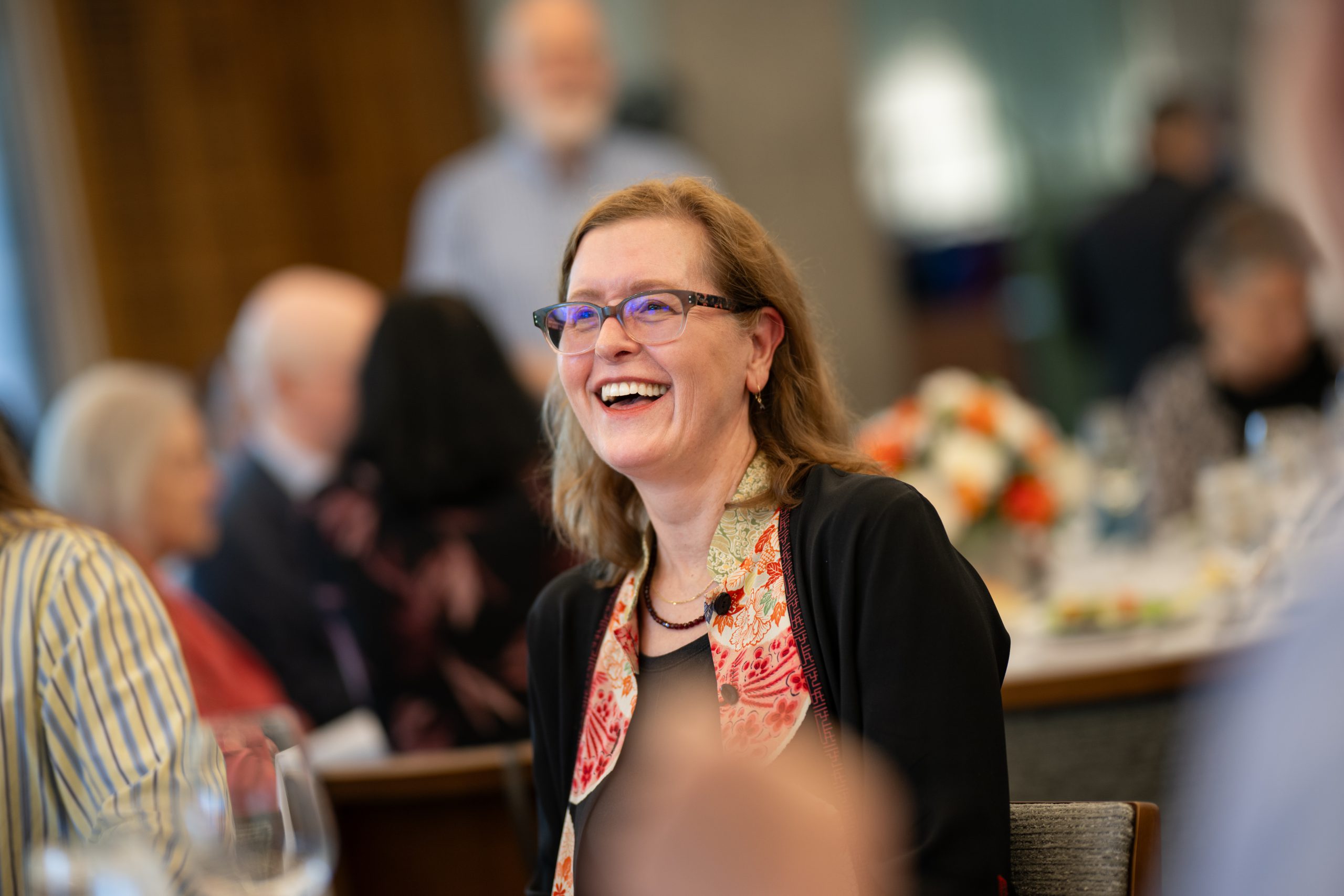A Tribute to Janet Currie’s Pioneering Work

The Economics of Children’s Health and Development conference, hosted by the Industrial Relations Section (IRS) of Princeton’s Economics Department and the Center for Health and Wellbeing (CHW), brought together dozens of academics and economists to celebrate Janet Currie’s contributions to Economics, especially in the field of Children’s Health and Development.
Currie is the Henry Putnam Professor of Economics and Public Affairs at Princeton University’s School of Public and International Affairs (SPIA), the co-director of the Center for Health and Wellbeing, and a faculty member of the Economics Department. Currie also co-directs the Program on Families and Children at the National Bureau of Economic Research.

Conference attendees, including Janet Currie, during a lecture at the Economics of Children’s Health and Development conference. Photo credit: Sameer Kahn/Fotobuddy
On Monday evening, June 16, conference attendees and presenters gathered at Pascaline Dupas’ home for a welcome reception. Dupas is a Professor of Economics and Public Affairs at Princeton University and the co-director of Princeton’s CHW. Presentations began on Tuesday morning as attendees heard from a range of experts over the course of the conference on topics related to Currie’s work, including infant and maternal health, social safety net, mental health, and long-term and intergenerational effects. View the full agenda for all lectures and discussion topics.
Tuesday evening, everyone attended a cocktail reception and dinner at Princeton’s Prospect House. During the festivities, several notable speakers shared stories and paid tribute to Currie and her pioneering work. One of the speakers was Orley Ashenfelter, the Joseph Douglas Green 1895 Professor of Economics at Princeton University, former Director of Princeton’s IRS, and one of Currie’s mentors. “It has been a pleasure to watch as Janet Currie has single-handedly created an empirical approach to the study of children and families that has provided deep insights into key behavior,” Ashenfelter said. “She is an economist who has sharp tools and a sharp eye for unresolved issues that are of great social significance.”
Currie also spoke, highlighting the impact this work has had on her life. “One of the things that has surprised me about academic life from the very beginning is how social it is. Since my first days in the Industrial Relations Section, we bandied ideas around the coffee bar, and I saw how we depend on each other to hash out ideas, as well as for guidance and support,” Currie said. “The stereotype of a scholar sitting in an ivory tower thinking great thoughts could not be further from the truth—teaching and learning is always a two-way street. I have learned an incredible amount from all of you and found that learning together is just way more fun than learning alone.”

Janet Currie smiling during the dinner reception at the Economics of Children’s Health and Development conference. Photo credit: Sameer Kahn/Fotobuddy
“It was such a joy to see so many of my students, coauthors, and colleagues,” Currie shared after the conference concluded. “I’m so grateful that they took the time to celebrate all our work together.”
Princeton’s IRS and CHW were honored to host this conference in celebration of Currie, who is retiring in July. We thank the attendees and speakers for their contributions to the conference. Prior to the event, a collection of Currie’s students, mentors, collaborators, and co-authors shared memories and stories paying tribute to her incredible career and impact. Watch the video on our YouTube channel. In addition to the conference, Currie’s former students have arranged a special journal issue in the Journal of Human Resources, featuring papers that were presented at the conference—more details on this publication will be forthcoming.
A Pioneer for the Economics of Children’s Health & Development
Prior to Janet Currie, the field of economic analysis of child development didn’t exist in any formal capacity. In fact, before 1993, when Currie published her first article on the topic, Welfare and Child Health: The Link Between AFDC Participation and Birth Weight, zero studies on child development had been published in top economics journals. Her work laid the foundation for research and academic investment.
“Deciding to make children the focus of my research, when there was no ‘field’ for it and no one else was doing it, was one of the hardest decisions I made as a researcher,” Currie said. “People told me that it was ‘interesting, but not economics.’ Plus, it was a stereotypically female concern.”
Starting in 1995, other researchers began to publish studies related to child development, making important contributions, including Cunha and Heckman (2007), Chetty et al. (2011), and Attanasio and Meghir (2012), which further advanced the field and solidified it as an essential area of economic study.
Currie’s current research focuses on socioeconomic differences in health and access to healthcare, environmental threats to health, the importance of mental health, and the long-term impact of health problems during pregnancy and early childhood. Economists often refer to these capabilities as “human capital,” a term intended to convey the idea that investments in these capabilities will yield positive returns for both individuals and society.
“While economists have long recognized the importance of human capital, Janet Currie’s groundbreaking work fundamentally transformed our understanding of its origins. Her work demonstrated how early childhood family and health environments—themselves shaped by social protection and other policies—play a critical role in economic outcomes,” said Pascaline Dupas. “In opening this previously unexplored domain, Currie not only established a new, important field of inquiry but also mentored a generation of exceptional scholars who continue to advance our knowledge of early-life determinants of human development.”
Another aspect of Currie’s research contributions involves the development of new methods for identifying the causal effects of interventions on children through the innovative use of existing, previously underutilized administrative data, such as vital statistics, natality and mortality records, environmental monitoring data, or hospital discharge data. By pioneering data linkages (often using then-new geocoding techniques) and identifying relevant control groups and “natural experiments,” she showed that it was possible to evaluate the effects of large-scale social interventions on children’s outcomes.
Currie continues to be a force for change and to drive continued research in the field. A few of her recent papers include “Doing More with Less: Predicting Primary Care Provider Effectiveness,” published in The Review of Economics and Statistics in March of 2025, which uses data from the Veterans Administration to examine the efficacy of primary care providers (PCPs), “Administrative Burdens and Child Medicaid and CHIP Enrollments,” published in the American Journal of Health Economics in Spring 2024, which provides the first national, quantitative assessment of the role of administrative burdens in driving the drop in child health insurance coverage since 2016, and “Socioeconomic status and access to mental health care: The case of psychiatric medications for children in Ontario Canada,” published in the Journal of Health Economics in January of 2024, which finds that, conditional on diagnosis and medical history, low-income children are more likely to be prescribed antipsychotics and benzodiazepines than higher-income children who see the same doctors.
In addition to her groundbreaking work paving the way to further research into children’s health and development, Currie is an enthusiastic and deeply admired professor. Her approach to teaching aims to encourage her students’ curiosity about the world, along with an understanding that learning is a continuous, life-long process.
On her teaching philosophy, Currie shares, “I hope to help students become not only more informed but more reasonable human beings as they hone the ability to evaluate evidence. Becoming aware of their own assumptions and biases is an important component of this process. A related goal is to foster critical thinking in a way that maintains a generous spirit. It is important for students to think about how they know what they think they know. They must learn to identify weaknesses in an argument. But an even harder lesson can be to find a kernel of insight in even a deeply flawed study.”
Currie enjoys mentoring her students and has acted as a Ph.D. supervisor with 50 successfully graduated students. She has also advised nearly 20 senior theses, and several of her advisees have won dissertation prizes and/or gone on to graduate school. Her mentees include women such as Anna Aizer, who became chair of the department at Brown, and Maya Rossin-Slater, who won the American Economic Association (AEA) prize for the best female economist under the age of 40.
This process is a two-way street, Currie says, adding, “as students become experts on their subjects, I learn a tremendous amount from them.” The one piece of advice she consistently shares with her students is, “Work on questions you care about, rather than choosing a subject because it is currently popular.”
Looking back on her career, it is clear that this advice stems from a wealth of experience. After all, if Currie had not persevered in her research on a topic she cared about, the field of economic analysis of child development would be light-years behind where it is today.
More About Janet Currie
Janet Currie is a member of the National Academy of Sciences, the National Academy of Medicine, and of the American Academy of Art and Sciences. In her 2025 Presidential Address to the American Economics Association (AEA), Currie spoke on “Investing in Children to Address the Child Mental Health Crisis.” She has served as the President of the American Economic Association (AEA) since 2024 and has previously served as the President of the American Society of Health Economics, the Society of Labor Economics, the Eastern Economic Association, and the Western Economic Association. Currie was instrumental in establishing the AEA’s widely copied mentoring program for female junior faculty and for conducting an experimental evaluation that demonstrated its positive effects. She won the AEA’s Carolyn Shaw Bell Award in recognition of her mentorship efforts in 2015.
In 2024, Currie was honored as a Clarivate Citation Laureate. SHe was the Distinguished CES Fellow in 2023, and a Fellow of the American Academy of Political and Social Science, the Society of Labor Economists, and of the Econometric Society, and has honorary degrees from the University of Lyon and the University of Zurich. In 2019, Currie was a NOMIS Distinguished Scientist, the winner of the 2023 Klaus J. Jacobs Research Prize, one of the top 10 women in Economics by the World Economic Forum in July 2015, and an Alumna of Influence by the University of Toronto in 2012. She has served on the Board of Reviewing Editors of Science, as the Editor of the Journal of Economic Literature, and on the editorial boards of many other journals.
Currie earned her B.A. and M.A. in Economics from the University of Toronto and her Ph.D. in Economics from Princeton University.